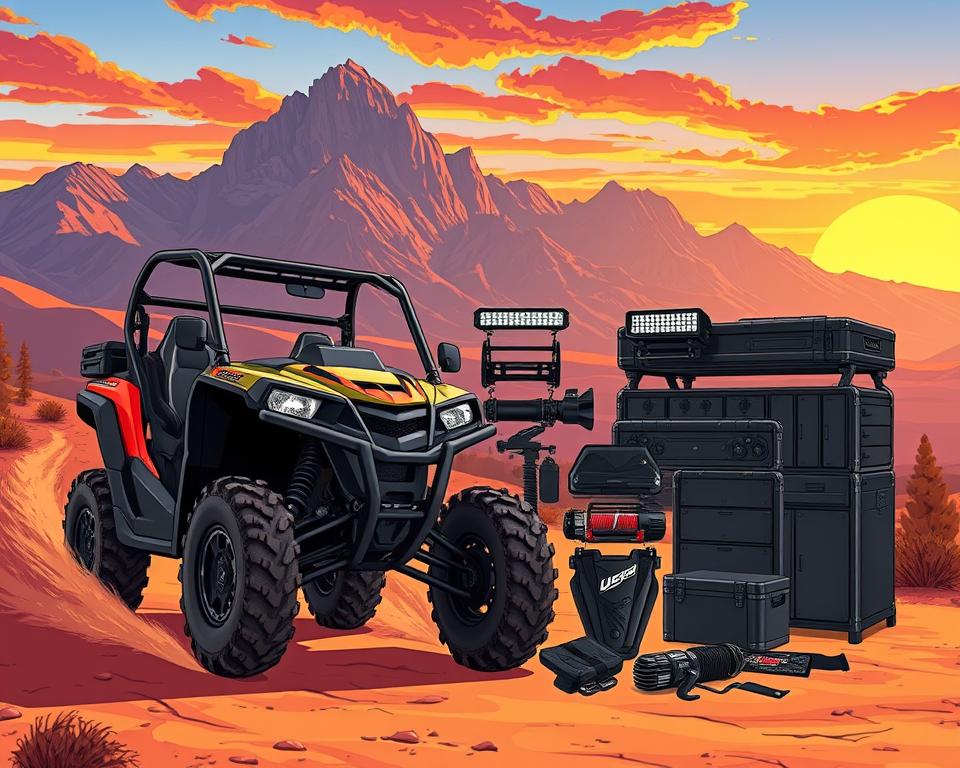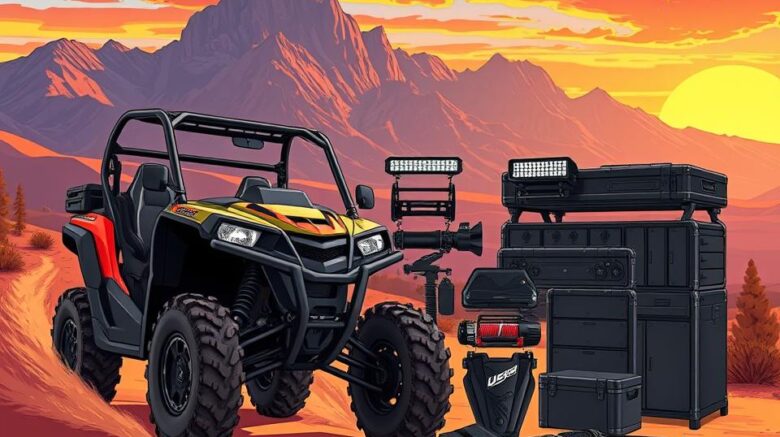Steering Clear of ATV/UTV Gearing Errors for Novices
Did you know that nearly 25% of new ATV and UTV owners face gear selection issues within their first year? This statistic underlines the importance of grasping ATV gear ratios for beginners. Correct gear choice protects against accidents as well as enhances power. Let’s dive into gearing missteps, care routines, and top defender snow plow tips to enhance your rides.
Central Ideas

- Knowing gear ratios is crucial for peak off-road power.
- Neglecting gearing details increases accident hazards.
- Regular maintenance is key to preventing UTV transmission issues.
- Proper gear selection greatly enhances off-road riding experiences.
- Following upkeep advice extends your ATV’s life.
Understanding ATV and UTV Gear Ratios
Ratios determine how engine output translates to drive force. They shape acceleration and pulling strength. This controls how quickly you get up to speed and tow trailers. Custom gearing shifts focus from speed to torque or vice versa.
Choosing the right UTV gear is key to understanding engine performance. A low gear ratio can hinder torque during steep climbs or when carrying heavy loads. Conversely, too high a ratio hampers quick takeoffs on flats.
Riders often tweak reduction ratios for trail versatility. By adjusting gear ratios, riders can customize their vehicle’s performance. It lets you balance acceleration with pulling force. Finding the sweet spot in gearing enhances ride quality and fuel economy.
Common Gearing Oversights for New ATV/UTV Owners
Proper gear choice underpins both power and protection. Rookies often miss key selection factors. Grasping misgear consequences and correct choices elevates your performance. Plus, it prevents mechanical setbacks.
Impact of Incorrect Gear Selection
Wrong ratios threaten stability and component life. Poor gear choice dampens speed, stresses brakes, and accelerates wear. Such errors endanger everyone, from driver to bystanders. Using maintenance best practices wards off these hazards.
Choosing the Right Gear for Terrain
Each surface demands its own ratio. Climbing requires low-end grunt from smaller ratios. Flats call for taller ratios to boost top-end. Soft ground demands careful gear choice for grip. Knowing these environmental factors is critical for safe and enjoyable off-road adventures.
The Importance of Proper ATV Maintenance
Regular maintenance is key to keeping ATVs and UTVs running smoothly. Adhering to care guides prevents sudden failures and enhances safety. A tailored service plan prioritizes drivetrain care.
Regular Inspection and Maintenance
A thorough inspection list catches troubles before they grow. Regularly inspect the drive train, stopping systems, wheels, and belts. Routine checks lead to peak performance. Here are some critical inspection points to remember:
- Check gear mesh and teeth condition.
- Verify hardware and linkages are secure.
- Check master cylinder and calipers for leaks.
- Inspect tire pressure and tread depth.
- Inspect battery terminals and cables for buildup.
Fluid Changes and Gear Health
Fluid quality is critical for UTV drivetrain maintenance. Frequent changes clear out contaminants. Fresh oil cuts wear and heat for lasting components. Adopting this routine preserves drivetrain health and trail readiness.
| Fluid Type | Recommended Change Interval | Benefits of Regular Change |
|---|---|---|
| Engine Oil | 50–100 operating hours | Cuts friction and boosts power |
| Differential Oil | 100–200 operating hours | Smooths shifts and prevents pitting |
| Coolant | Once per year | Prevents overheating, maintains optimal temperature |
Adhering to this schedule grants worry-free adventures. This makes every journey more enjoyable.
Common ATV Gear Shifting Problems
Many beginners wrestle with the gearbox. Developing fluid shift skills elevates trail enjoyment. It reduces frustration on the trails. Proper coordination of the throttle and clutch is key for control and avoiding shifting problems.
Learning to Shift Smoothly
Honing silky shift skills takes deliberate training. First, feel your engine’s rev pattern. Careful engagement protects internals and stops wear. Matching revs while you let out the clutch is essential.
Drill shifts in an open space to build skill. Focus on gentle throttle application during each gear change.
Recognizing Signs of Gear Issues
Spotting problems early prevents breakdowns. Watch for whines, clanks, or crunches in the gearbox. Stuck gears or false neutrals are warning signs. Spotting these signs early can prevent major damage and ensure a safer ride. Addressing ATV gear shifting problems properly maintains vehicle performance and boosts your confidence while riding.
Understanding UTV Transmission Issues
Dealing with UTV transmission problems can be tough, but knowing the common issues is vital for troubleshooting. Owners often face issues like slipping gears or odd noises. Below we break down common failures and the tools to troubleshoot them. Leveraging user-friendly diagnostic procedures.
Diagnosing Common Problems
Recognizing the signs of transmission troubles is essential. Common issues include:
- Gears that pop out under load, risking accidents.
- Weird whines or crunches hinting at worn parts.
- Signs of fluid seepage that threaten gearbox health.
Routine checks uncover faults early. You can then address issues swiftly. Overlooking warnings costs more in the long run.
Solutions for Troubleshooting UTV Transmissions
Fixing UTV transmission issues requires a systematic approach. Follow these steps for effective troubleshooting:
- Check fluid levels and top up if necessary.
- Inspect pan and seals for drips.
- Assess internal components for wear or chipping.
- Operate the UTV under different loads to observe shift quality.
- Reference factory troubleshooting charts for your UTV.
Using a reliable UTV troubleshooting guide can streamline the process. Grasping drivetrain theory helps maintain your rig. It greatly enhances your vehicle’s longevity and efficiency.
ATV Clutch Adjustments and Their Benefits
Proper ATV clutch adjustments are key to a great riding experience. Incorrect adjustments can make shifting gears tough, frustrating for beginners. Frequent tuning enhances clutch grip and shift precision.
Precision in gear changes is critical. An optimally adjusted clutch ensures quick and smooth gear changes. This enhances the ATV’s power delivery, making rides more enjoyable on different terrains.
Neglecting clutch upkeep accelerates wear and reduces power. Consistent adjustments sustain peak clutch function. It’s critical for both new and seasoned riders to ensure their ATV performs at its best.
Mastering the Art of Gear Shifting
Mastering gear shifting techniques greatly enhances your riding experience. Understanding drivetrain function and shift timing is crucial. Rookies need to practice gear timing. A steady shift rhythm yields cleaner transitions and more power.
Skillful shifting comes from drilling in diverse environments. Understanding when to shift gears based on terrain type enhances control and safety. Dropping a gear before a climb preserves torque and control.
- Practice shifting at low speeds to build confidence.
- Listen and feel each gear engagement.
- Advance to tougher conditions to refine technique.
Tuning into your ATV’s feedback is key to shift mastery. Listen for pitch changes and shudders to guide engagements. These cues pinpoint exact shift timing. That instinctive skill yields seamless shifts and more fun.
Best Practices for UTV Gear Selector Problems
Managing UTV gear selector problems demands a proactive maintenance and diagnostic approach. Regular inspections are key to spotting issues early. Learning proper lever use minimizes failures. Routine checks should include visual inspections of the selector linkage and fluid levels, which are vital for performance.
When facing gear selector issues, first check the selector mechanism for obstructions or damage. Squeaks might indicate misalignment. A quick tighten or lube can restore function. A routine plan stops small faults from growing.
Logging selector behavior in varied rides highlights issues. These best practices not only extend the gear selector’s life but also make riding safer and more enjoyable.
Tips for Enhancing Gear Performance
Maintaining optimal gear performance requires a proactive approach. Regular maintenance is key to improving ATV efficiency. Verify oil levels, examine parts, and tweak calibrations. A simple inspection can prevent extensive damage and costly repairs.
Selecting proper reductions yields prompt acceleration and fluid movement. Understanding the terrain you will face allows you to select the appropriate ratios. This decision impacts everything from acceleration to top speed. Partnering with trusted makers like American Off-Roads for UTV performance enhancements adds power and reliability.
Utilizing gear performance tips focused on tire selection, suspension adjustments, and weight distribution can further improve overall gear efficiency. Those mods lead to stable, confident rides across tough terrain. Your rides become more fun and less fatiguing. Implementing these strategies will allow riders to navigate with confidence while enjoying the thrill of the ride.
The Final Word
Mastering ATV/UTV gearing is essential for performance and safety. Matching gears to ground types transforms your adventure. Dodging typical pitfalls and choosing wisely delivers memorable, safe outings.
No less crucial is keeping your drivetrain in top trim. Scheduled maintenance and TLC save you from breakdowns and prolong service. Good upkeep maximizes output and secures your rides in all conditions.
Understanding gear selection and prioritizing maintenance leads to a more fulfilling experience for ATV/UTV fans. Following these guidelines paves the way for endless trail excitement.
Frequently Asked Questions
Standard gear ratios on off-road rigs?
ATVs and UTVs have gear ratios that vary widely, depending on the model. Typical ratios lie within the 3-to-5 range. Smaller ratios deliver grunt for trails and climbs. Higher ratios, on the other hand, can increase top speed on flat terrain.
How to spot unsuitable gearing?
Misgearing risks unstable handling, rev overload, or sluggish starts. Mud, sand, rocks, and snow each call for tailored gear choices.
Warning signs for upkeep on your off-road vehicle?
Head off issues if shifts go crunchy, the box hums, oil drips, or power falls off. Regular checks of the gear system can prevent major issues.
When to swap your drivetrain oils?
Change the gear fluids every 1,500 to 2,500 miles, or at least once a year, depending on usage and terrain. Pure oils maintain smooth shifts and protect internals over time.
What techniques should I use for smooth gear shifting?
For smooth gear shifting, practice coordinating the throttle and clutch. Feather the clutch up while winding the throttle for a perfect match.
Steps to diagnose gearbox problems?
Start by checking for common problems like slipping gears or strange noises. Inspect the transmission fluid level and condition. Then, perform a basic diagnostic to identify any mechanical failures.
Why adjust your ATV clutch?
Proper clutch adjustments are essential for smooth gear transitions. Incorrect clutch setup strains the gearbox and causes sticky shifts.
How can I improve my gear performance on different terrains?
Test multiple gearing options and look into quality mods by American Off-Roads. Regular maintenance, such as checking gear health and fluid levels, also enhances performance.
When your UTV shifter sticks?
Regular inspections and routine maintenance are key. For jams or mis-engagements, follow your manual’s diagnostic steps.
Beginner pitfalls in gear selection?
Beginners sometimes skip ratio learning, skip services, or stay in the wrong gear for conditions. Such errors cause subpar power delivery and increased accident risk.
